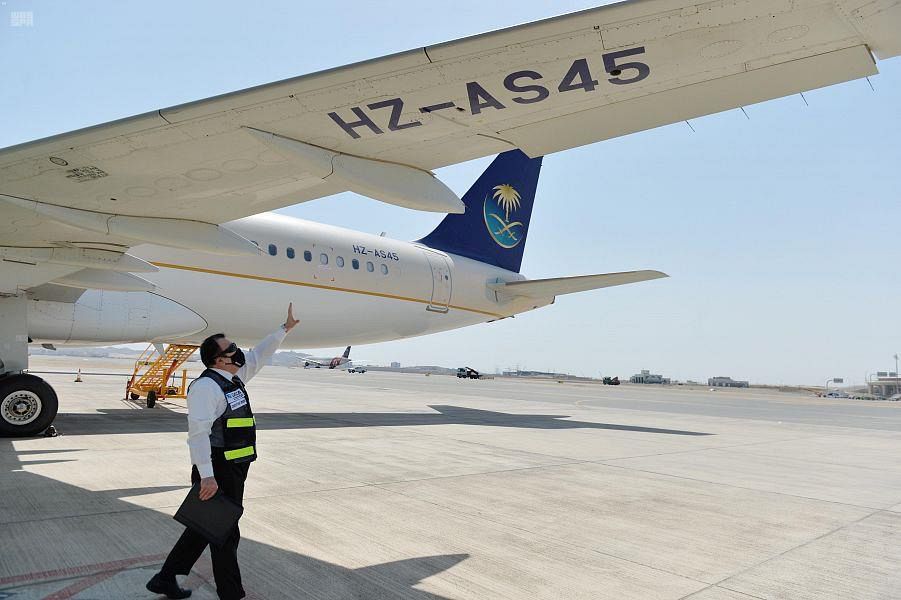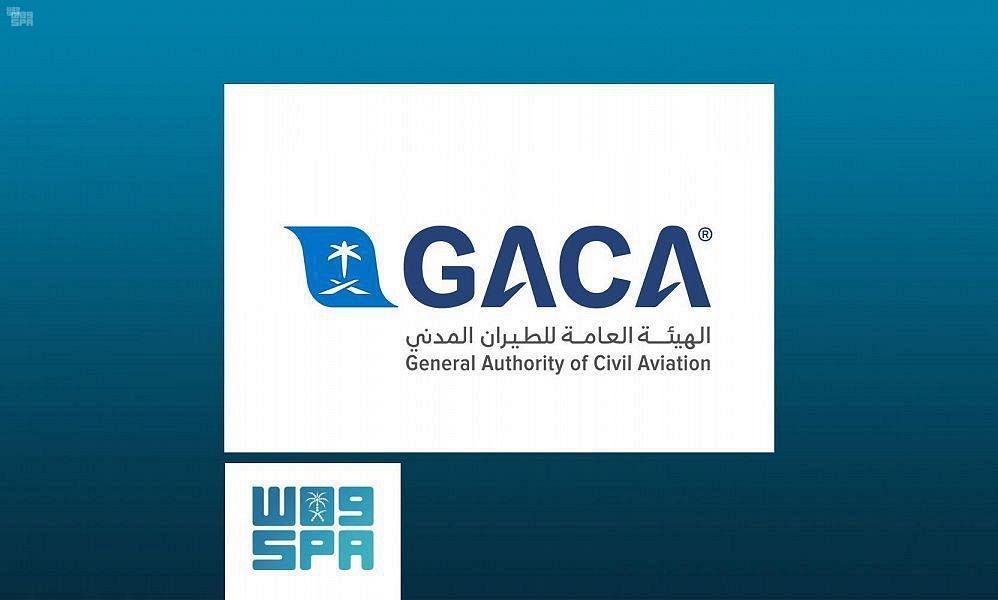
RIYADH — The General Authority of Civil Aviation (GACA) currently follows all procedures to issue an Airworthiness Certificate that are in line with the international rules and recommendations issued by the International Civil Aviation Organization (ICAO) mentioned in Annexes VI and VIII of the Chicago Convention, including the required form of the certificate.
The procedures are stipulated in Article 31 of the Aviation Agreement of the International Civil Aviation Organization (ICAO) known as the (Chicago Convention).
It is well established that civil aircraft flies all over the world to transport passengers and goods, and every aircraft used in international navigation receives a Certificate of Airworthiness, or an approval by the country in which the plane is registered after ensuring the safety and suitability of the aircraft.
The Airworthiness Certificate is defined as “a document issued by GACA to the country of registration of the aircraft in which the aircraft’s validity to fly is approved during a certain period of time, provided that the operator is committed to following the conditions contained therein.”
Thus based on its mission to achieve a safe atmosphere in accordance with the most accurate global safety standards, GACA routinely conducts continuous inspection of civil aircrafts at Saudi airports. This is in addition to conducting scheduled and unscheduled inspection campaigns on air operators to ensure that they meet the requirements for continuity of airworthiness.
Furthermore, to ensure the implementation of the aircraft maintenance and operation program according to the highest international standards, and to help raise the aircraft"s operational readiness.
The procedures for issuing the Airworthiness Certificate are according to the guideline issued by GACA, and are divided into two types (the Standard Certificate of Airworthiness and the Special Certificate of Airworthiness). The standard Airworthiness Certificate is also required for the aircraft to have a (Type Certificate) which is approved in accordance to Part No. 21 of GACA’s Regulations.
Moreover, it requires that that the aircraft conforms to the approved design and is in a condition that allows for safe operation, and that the major modifications to the aircraft’s design are made according to an additional Model Certificate, a Supplemental Type Certificate (STC) issued by GACA, or based on engineering accreditation acceptable to GACA according to the guidelines AC 021-03.
This is in addition to a strict compliance with all Airworthiness Directives issued on the aircraft type, and compliance with the additional airworthiness requirements required according to the nature of the operation. Further, it’s required that the aircraft is equipped with the minimum equipment required according to the nature of operation.
The GACA performs many technical procedures before issuing the Airworthiness Certificate, as the work is divided into four stages. First of which, is an office review that begins with receiving the request for issuing, or renewing the Airworthiness Certificate submitted by the air operator through the electronic services on the GACA’s website on the Internet, where the application is reviewed by a specialists in the General Administration of Airworthiness of the Aviation Standards Sector at GACA.
There, the Airworthiness Inspector reviews technical data related to the aircraft to make a technical assessment about the history of the aircraft, its current condition, its equipment, the design modifications, major repairs, and ways to comply with Continuing Airworthiness instructions. Thereafter, a coordination plan is made with the air operator to determine the date and location of the inspection.
The second stage includes the inspection visit, where the inspector makes a field visit airside to inspect and check the aircraft and make sure that the air operator has fixed any defects that appeared during the inspection process and therefore determine if the aircraft meets all of GACA requirements to issue the certificate of airworthiness, or not.
The aircraft inspection includes three areas, namely, Aircraft Exterior Inspection, Interior Area, and Cockpit. During the inspection of the aircraft exterior, the inspectors checks the front of the aircraft, making sure that there are no apparent damages, examine the sensors area of the aircraft"s velocity measuring devices and the angle of wind gusts.
An examination of the landing gears group is then followed, which includes, the aircraft brakes and the hydraulic systems in the central area of the aircraft’s hull, to make sure there is no leakage of fluids. Thereafter, an inspection of the wing of the plane, including the moving parts and lights, to make sure that there are no damages, as it is a possible area exposed to bird strikes.
Furthermore, inspection of the aircraft’s exterior area also includes checking the interior of the aircraft’s engines, the rear of the aircraft, to ensure the integrity of the rear wing and tail, the Auxiliary Power Unit (APU), and making sure of the absence of any damages, to ensure the requirements of the aircraft’s Registration Mark.
The inspectors, then, move on to the Cargo Compartment inspection process to ensure that it meets the fireproof design requirements, and to test the fire alarm devices installed inside of it, that are connected to the cockpit. This in addition to an operational test of the cargo systems, and to make sure of the existence of the instructions for storing the luggage approved by the aircraft manufacturer.
From inside the aircraft, the Airworthiness Inspector checks the cockpit and ensures the operational status of the electronic screens, systems and control equipment of the plane, as well as the safety and clarity of vision through the windows of the cockpit, making sure the absence of any fractures, or cracks in them.
Meanwhile, to ensure the availability of emergency and safety equipment for the cabin crew, inspectors also makes sure of the existence of the aircraft"s operating manuals, and reviews the aircraft"s maintenance logbook, which contains a list of faults and repairs made on the plane, as this record is a reference for the captain of the aircraft to ensure the safety of the aircraft and make a decision to prepare for the flight.
Among the procedures carried out by safety inspectors inside the aircraft is to ensure the presence of safety equipment that must be available according to the nature of the operation of the aircraft. This includes, fire extinguishers, fire alarms, oxygen masks, first aid bags, pacemakers, guidance microphone, and life jackets.
Moreover, to ensure the safety of passenger seats and seat belts. The internal inspection also covers the passenger compartment, which includes inspections of the food and beverage Galley, and lavatories.
This is in addition to ensuring the operation of emergency evacuation systems and the availability of usage and safety instructions card for passengers, as well as corridor lighting systems, the presence of the emergency locator transmitter (ELT), which is one of the requirements that must be met by all aircraft licensed to transport passengers.
In the third stage, which is known as the certificate issuance, the Airworthiness Certificate is printed and approved by GACA’s management and handed over to the air operator to place it inside the cockpit, while the fourth phase is a continuous follow-up process, which takes place after a year from the date of issuance of the certificate, in the event it was issued for three years.
GACA is also working to implement aviation safety standards with regard to aviation information, and to license service providers (flight information, design of flight procedures, air inspection of navigational devices, air assessment of flight procedures, and authorization of delegates to study aviation obstacles).
Further, after all these licenses are issued, GACA conducts inspection visits, announced and unannounced, to service providers to ensure the implementation of GACA Executive Regulations and file the necessary reports thereafter.
GACA also seeks to develop the air transport industry in accordance with the latest regulations and in line with the latest developments in the aviation industry at the international level. It further works to continue maintaining the highest safety standards in the Kingdom, and works to update laws and regulations in line with developments in the aviation sector globally.
Furthermore, GACA issues and renew licenses, accreditation and certificates for the civil aviation industry in accordance with laws and regulations. It further ensures compliance with regulations and procedures. This is in addition to conducting regular monitoring checks ensuring the highest possible safety levels. — SG










